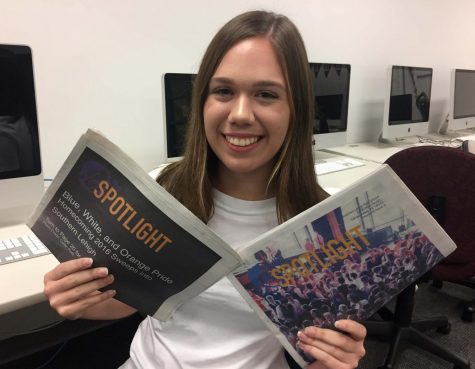College Applications Raise Questions Regarding Race
In 2010, the Department of Education mandated that all colleges and universities begin collecting additional data about race. In most variations of college applications, this new rule allows multiracial students to check off multiple boxes for their race. However, according to Diffen Research, the definition of “multiracial” varies from person to person, as race may depend on self-expression, physical appearance, family relations, and perception. The U.S. Census Bureau says the multiracial group is expected to triple by 2060.
“Colleges don’t require you to report if you are a certain percentage [of a race],” guidance counselor Mrs. Tamme Westbrooks said. “That’s such a sensitive area, and colleges have to be very careful about how they are questioning it.”
“I feel like you have to be at least a quarter of something different [to be multiracial],” sophomore Sana Gold said. “For example, you can’t be three-fourths English and then one-quarter Italian to be multiracial. That’s just two variations of white. It needs to be from totally different continents, not just different countries.”
The Common Application, which includes Hispanic or Latino, American Indian or Alaska Native, Asian, Black or African American, Native Hawaiian or Other Pacific Islander, and White (including Middle Eastern) as race options, is used by 696 schools. This means that most students will eventually encounter the same question about their race and will have to choose the boxes of the races with which they identify.
“When I fill out those boxes, I check ‘Indian,’ ‘Asian,’ ‘Middle Eastern,’ and ‘White’ if they are there, simply because it’s in my blood,” senior Amir Gold said. “I identify as part ethnically Jewish, even though I, like many of my Jewish peers, don’t necessarily believe or participate in the religion.”
What makes this issue so controversial is that if even a small number of students fabricate their race, it decreases the chances for students who are actually multiracial to get into a given college. The appeal to lie is tempting for many students because it’s so easy to check off a box. Making yourself seem like a minority may increase your chances of making it into a certain school as there is a higher acceptance rate for multiracial students and minorities because there are fewer of them applying.
Among students who identify as two races, 90 percent identify as both black and white. According to Georgia Southern University, what makes these students so different is that “the division between black and white populations puts biracial and multiracial people in an interesting position.” They have different experiences from each culture to bring to colleges, whereas most students only have one.
Many white students will bring forth their limited Native American or Latino ancestry to make themselves more attractive. They may not identify with the culture, and these ethnicities may represent only a small percentage of their heritage, but it makes them seem different from other applicants. Checking the box takes just one second, but the cost of doing so is a load of guilt, and numerous penalties if a college figures it out.
For instance, Information about ethnicity could be transmitted on some other document such as SAT scores or a high school transcript. If there is a discrepancy, colleges may reject you and tell other colleges about the incident, potentially preventing a person from being admitted into any colleges.
In one example, an unnamed student had received an offer to be flown out to a college and visit the campus because he wrote down “Indian” in the “other” box on an application. His ancestry was from the Asian subcontinent of India, and he was not Native American. The college assumed that he was Native American and accused him of lying. They revoked their original offer and told all other colleges to which he was applying that he lied. This delayed his acceptance into any college.
“You should be able to check any box that you identify or feel comfortable with. But that doesn’t mean you can be, for example, white and check off African-American because that’s the way you feel,” sophomore Hannah Grim said. “Sounds ridiculous, but it’s a real thing.”
Moreover, here are many races that don’t fit into the listed boxes. The narrow categories force students to conform or choose the “other” box, which sometimes marginalizes minority students because it creates the suggestion that they “don’t fit in” or aren’t as important as the other races. While, it’s a good option to have the “other” box, many people support adding more boxes to choose from.
“I think they should add more boxes, but not too specific because of how many races there are,” sophomore Terrell Dinkins said. “I think a separate Middle Eastern box would be a good fit.”
Multiracial students using other types of applications that only allow one race to be checked, such as the Universal Application or the Coalition Application, face a different problem: which part of their ethnicity do they choose to represent their identity?
The issue of whether or not colleges should add boxes brings up the question of whether they should exist at all. Last year, the Supreme Court upheld the decision to allow colleges to select students with consideration to race and ethnicity so that all applicants could have an equal shot. Collecting information about race allows colleges to maintain diversity on their campus. However, to many, the boxes themselves seem unnecessary because they force students to categorize themselves.
“All together we should get rid of that option on applications because chances are somewhere in our history we [have] other descendants that we might not know about,” senior Bryanne Kelly said. “A lot of people generally don’t know either what they are or what percentage of the ethnicity they are.”
Some students also feel they face discrimination when revealing their actual races. For example, Asian students are closely scrutinized because of the high number of them applying to elite schools. In order to maintain diversity on campus, colleges may select less qualified white, black, or Latino students instead of more highly qualified Asian students. Because only a given number of Asian students will be accepted, there is increased competition among them, as they have to be the best within their demographic.
The limited number of boxes, discrimination against certain races, and even having race questions on a college application creates limitations and obstacles for nearly all students. Checking off a single box, or more than one in some cases, can determine an applicant’s chances of getting into their dream school. The fine line between truth and dishonesty can be deceiving.

Senior Bridgette Lang is a third-year staff reporter and former features editor, now serving as opinion and our world editor for the Spotlight. In addition,...

